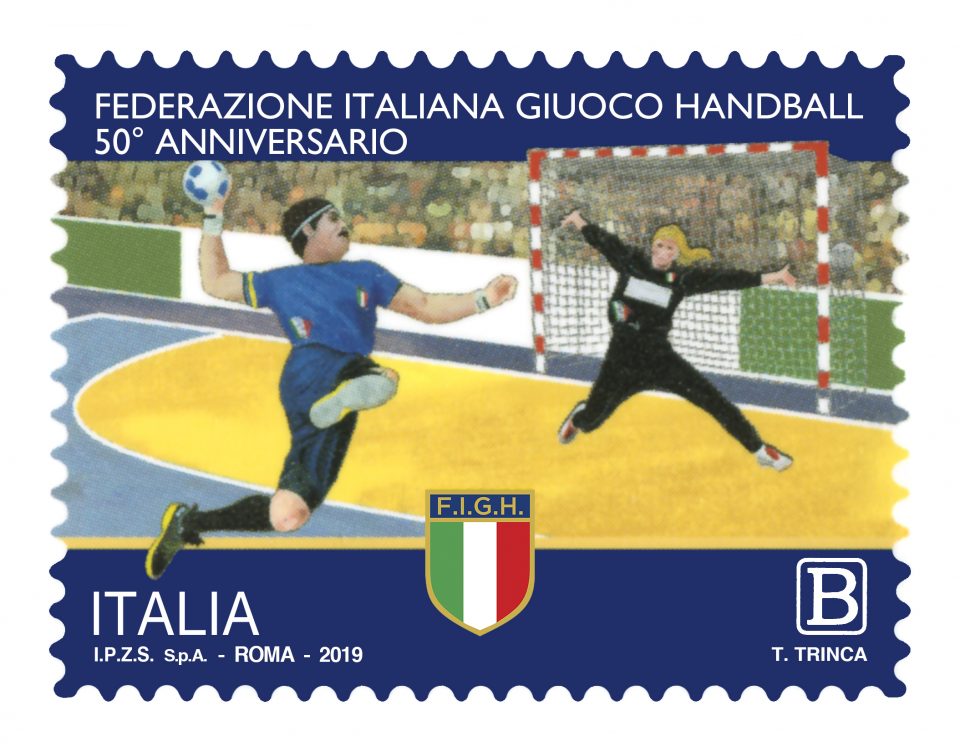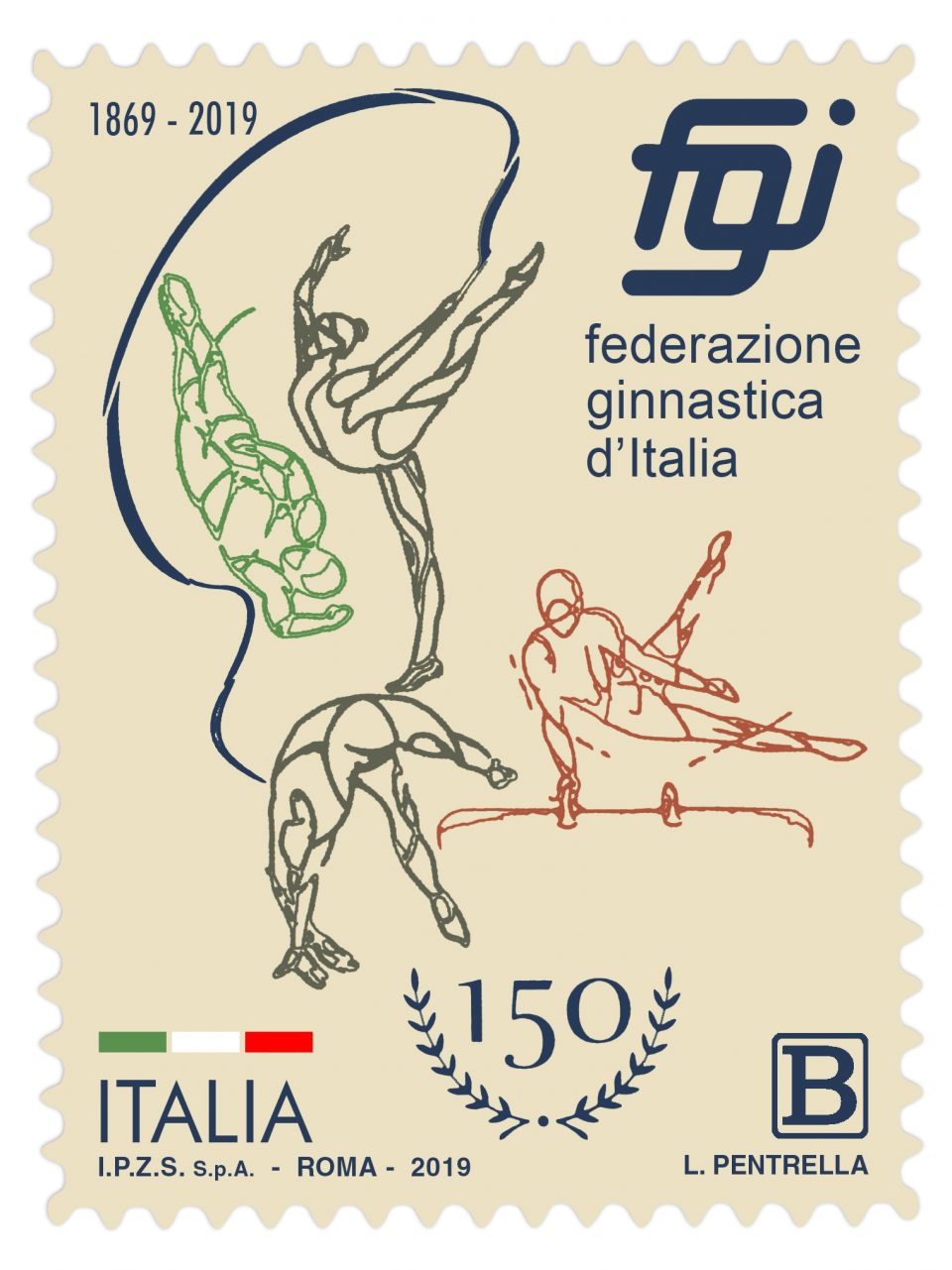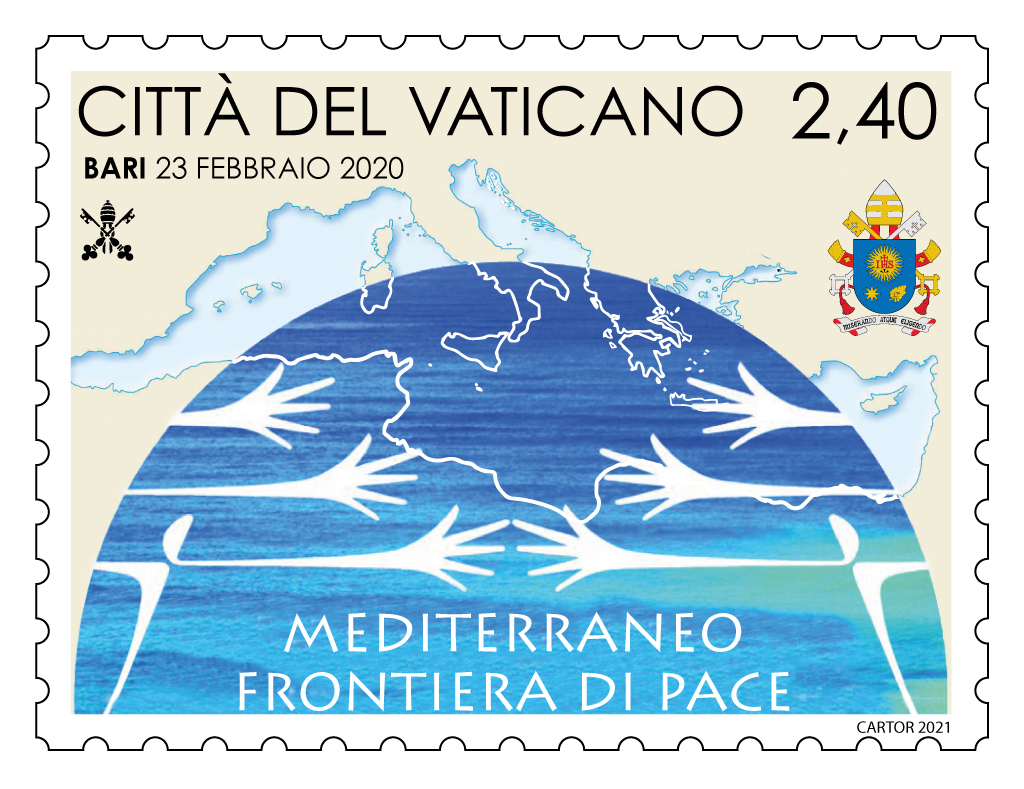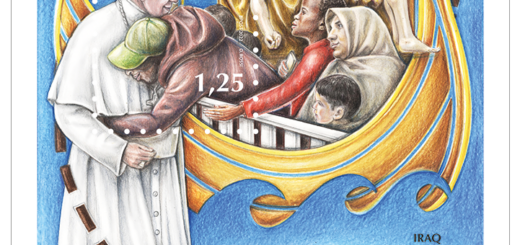POSTE ITALIANE 57^ emissione del 05 novembre 2019 di due francobolli dedicati alla Federazione Ginnastica d’Italia e alla Federazione Italiana Giuoco Handball, rispettivamente nel 150° e nel 50° anniversario della fondazione.
POSTE ITALIANE 57^ emissione del 05 novembre 2019 di due francobolli dedicati alla Federazione Ginnastica d’Italia e alla Federazione Italiana Giuoco Handball, rispettivamente nel 150° e nel 50° anniversario della fondazione.
Il Ministero dello Sviluppo ha emesso il 5 novembre 2019 due francobolli ordinari appartenenti alla serie tematica “lo Sport” dedicati alla Federazione Ginnastica d’Italia e alla Federazione Italiana Giuoco Handball, rispettivamente nel 150° e nel 50° anniversario della fondazione, relativi al valore della tariffa B, corrispondenti ognuno pari ad € 1.10.

- data / date 05 novembre 2019
- dentellatura / serration 11
- stampa / printing fustellatura/rotocalco
- tipo di carta / paper type bianca patinata neutra
- stampato / printed I.P.Z.S. Roma
- tiratura / edition 500.000
- fogli / sheet 45
- dimensioni / dimension 30 x 40 mm
- costo / price B = € 1,10
- bozzettista/ designer Tiziana Trinca
- num. catalogo Mi 4168 YT 3929 UN

- data / date 05 novembre 2019
- dentellatura / serration 11
- stampa / printing fustellatura/rotocalco
- tipo di carta / paper type bianca patinata neutra
- stampato / printed I.P.Z.S. Roma
- tiratura / edition 500.000
- fogli / sheet 45
- dimensioni / dimension 40 x 30 mm
- costo / price B = € 1,10
- bozzettista/ designer Lorenzo Pentrella
- num. catalogo Mi 4167 YT 3928 UN

La Federazione Ginnastica d’Italia (abbreviato F.G.d.I. o F.G.I., conosciuta anche con l’appellativo contratto Federginnastica) è l’organo che controlla e organizza le competizioni di ginnastica in Italia. Ha sede a Roma. È affiliata alla Federazione Internazionale di Ginnastica e all’Unione Europea di Ginnastica ed è riconosciuta dal C.O.N.I.. È stata fondata nel 1869 ed è stata la prima Federazione sportiva della storia d’Italia.
Storia
Gli esordi
La prima federazione italiana di ginnastica fu fondata il 15 marzo 1869, con la denominazione Federazione Ginnastica Italiana, durante il 1º Convegno Ginnastico Italiano, che si tenne a Venezia su iniziativa di Costantino Reyer, Domenico Pisoni e Pietro Gallo. Essa riunì i Circoli Ginnastici, il Tiro a Segno e la Scherma; il presidente era Francesco Ravano. Gli intenti della federazione erano lo sviluppo di nuove Società ginnastiche (al tempo in Italia ne esistevano solo 6, mentre in Germania erano due migliaia) e la risoluzione dei problemi dei maestri di ginnastica, allora sottopagati e sottostimati.
Durante il Congresso di Bologna, terminato il 20 settembre 1874, le società affiliate si scissero in due federazioni, a causa di una contrapposizione tra gli ideali di un metodo “tradizionale” militaristico e di un metodo più innovativo, libero e naturale: le società più vecchie rimasero fedeli alla Federazione Ginnastica Italiana, le società venete ed emiliane fondarono la “Federazione delle Società Ginnastiche Italiane”. Dal 1878, per opera del Ministro della Pubblica Istruzione Francesco Saverio De Sanctis la ginnastica fu resa obbligatoria quale nuova materia di insegnamento. In seguito fu il Ministro della Pubblica Istruzione Todaro a migliorare la legge, nel 1893.
FGI e FSGI si riunificarono durante un congresso svoltosi dal 18 al 21 dicembre 1887 in Campidoglio; il nuovo organismo prese il nome di “Federazione Ginnastica Nazionale Italiana” (F.G.N.I.). Il presidente divenne il generale Luigi Gerolamo Pelloux, riaffermando così un’impostazione militaristica della ginnastica.
Con la trasformazione di molti giochi in discipline sportive, la F.G.N.I. accolse nel 1895 il football, dapprima quale manifestazione dimostrativa, ed in seguito attribuendo, durante i propri Concorsi Ginnastici, il titolo di «Campione d’Italia» attraverso appositi tornei. Promotore e divulgatore delle regole della “Football Association” fu il bolognese Francesco Gabrielli (1857-1899), Maestro Ginnasta ed educatore presso le Scuole e la Società Ginnastiche rodigine, dove si prodigò per il miglioramento delle discipline ginnastiche e per l’introduzione di nuovi giochi sportivi, soprattutto grazie al continuo confronto con esponenti della medicina sportiva e con membri delle federazioni sportive straniere, soprattutto tedesche, francesi ed inglesi.
L’8 settembre 1896 la FGNI fu riconosciuta Ente Morale.
Inizio Novecento
Nel 1901 la F.G.N.I. riprese la vecchia denominazione “F.G.I.”, che abbandonò nel 1909 per tornare al nome precedente. L’industrializzazione dell’Italia aiutò la ginnastica ad uscire dalla stretta cerchia degli sport d’élite, e dall’eccessivo militarismo a cui diversi governi impedivano il rinnovamento, frenando quelle che erano ritenute pericolose spinte al liberismo. A partire dal 1908, con l’approvazione della legge che introduceva la domenica festiva, il movimento sportivo italiano trovò gli spazi per poter sviluppare tutti gli sport. La popolarizzazione di tutte le manifestazioni ginnico-sportive e del calcio fu una delle principali conseguenze; i limitati e costosi spazi indoor non consentivano a tutte le nuove società sportive di emergere, mentre i nuovi sport all’aria aperta, quali podismo e ciclismo, riscuotevano notevoli successi, ed il calcio attecchiva a livello provinciale.
Alcuni anni dopo la fine della Prima guerra mondiale, le FGI cambiò nuovamente denominazione, diventando “Reale Federazione Ginnastica Italiana” (R.F.G.I.). Nel 1920 la RFGI si aprì un settore di agonismo, per mantenere un successo pari a quello degli sport più accattivanti per i giovani: l’educazione fisica veniva mantenuta per tutta la popolazione, mentre la ginnastica agonistica era per campioni selezionati.
Nel 1945 la società passò all’attuale denominazione Federazione Ginnastica d’Italia (F.G.d’I.). Ci fu una crisi della ginnastica e della FGI nel dopoguerra, a causa del calo delle società ginnastiche (da 149 nel 1946, a 129 due anni dopo), della mancanza di fondi, della requisizione delle palestre per gli sfollati, dell’assenza di mezzi.
La ripresa moderna
Nel 1952 la ginnastica ritmica entrò nei programmi scolastici, sotto la denominazione di “Ginnastica femminile moderna”. Nel 1960 cominciò la fuoriuscita della ginnastica italiana dalla crisi del dopoguerra: alle Olimpiadi di Roma Giovanni Carminucci conquistò l’argento alle parallele, la squadra maschile conquistò il bronzo, Franco Menichelli vinse il bronzo al corpo libero. Il segretario della federazione, Angelo Riva, ripropose quella politica del “doppio binario” nata negli anni venti, che promuove sia la ginnastica artistica (agonistica e individuale) sia quella popolare e di massa, una idea che è tuttora alla base dei programmi federali. Nel 1970 è stata istituzionalizzata la sezione di Ginnastica ritmica tra le attività ufficiali della Federazione.
Nel 1999 la FGI è diventata Ente privato di rilevanza pubblica sottoposto alla vigilanza del CONI, a seguito del decreto Melandri; il CONI mantiene così il potere di indirizzo e controllo della Federazione.
Nel 2000 viene eletto alla presidenza della Federazione Riccardo Agabio, che incentiva lo sviluppo delle attività di base, e costituisce due grandi settori, la Ginnastica per tutti e la Ginnastica Olimpica.
Nel 2008, alle Olimpiadi di Pechino, la Federazione si presenta con tutte le quattro Sezioni Olimpiche, per la prima volta da quando esistono le qualificazioni.
Se sei interessato all’acquisto di questo francobollo lo puoi acquistare al prezzo di €1.50. Inviami una richiesta alla email: protofilia1@gmail.com

- data / date 05 novembre 2019
- dentellatura / serration 11
- stampa / printing fustellatura/rotocalco
- tipo di carta / paper type bianca patinata neutra
- stampato / printed I.P.Z.S. Roma
- tiratura / edition 500.000
- fogli / sheet 45
- dimensioni / dimension 30 x 40 mm
- costo / price B = € 1,10
- bozzettista/ designer Tiziana Trinca
- num. catalogo Mi 4168 YT 3929 UN
La Federazione Italiana Giuoco Handball (FIGH) si occupa della promozione della Pallamano (Handball) in Italia. È una federazione affiliata al CONI e alla International Handball Federation (IHF).
Storia
Una prima federazione prese parte al congresso del CONI del 1946, con solo voto consultivo. Nel 1966 fu fondato un Comitato Promotore per la Diffusione della Pallamano, la cui opera culminò con la fondazione della FIGH, il cui atto costitutivo fu redatto il 20 dicembre 1969.
La Pallamano ha origini moderne, ma affonda le sue radici nell’antichità. Nonostante, infatti, la versione attuale della disciplina sia stata codificata solo a partire dalla fine del XIX secolo e sottoposta a diverse revisioni, volendo rintracciarne gli antecedenti storici di tale disciplina si può osservare che la Pallamano presenta affinità con diversi giochi dei secoli passati. L’Urania degli antichi greci, cui fa riferimento Omero nell’Odissea parlando di Nausicaa e delle sue ancelle, l’harpastum dei romani e il gioco del pallone, diffuso nel Medioevo.
LA PALLAMANO MODERNA
La Pallamano moderna si è tuttavia sviluppata nell’ultimo decennio dell’800 su canali paralleli. In Cecoslovacchia, dove gli insegnati di educazione fisica Josef Klenker e Václav Karas regolamentarono l’hazena, un gioco sette-contro-sette su campo coperto.
In Danimarca, dove un maestro di ginnastica di nome Holger Neilsen – già vincitore di medaglie nella scherma e nel tiro ai Giochi di Atene – inventa l’haandbol, che ebbe un successo immediato e le cui regole sono quelle su cui si fonda lo sport attuale.
In Germania, dove il gioco si sviluppa ulteriormente in diversi momenti. Nel 1892 quando Konrad Koch – rifacendosi a regole e movimenti di attività tradizionali come il Volkerball e il Korball – inventa il Raffballspiel, negli anni della prima guerra mondiale con il Torball, inventato da Max Heiser e inizialmente riservato alle donne, nel 1917 quando un più moderno set di regole viene pubblicato dallo stesso Heiser, da Karl Schelenz e Erich Konigh.
È con la definitiva messa a punto operata da Karl Schelenz nel 1919, che la pallamano assume connotati simili alla versione attuale, nonostante venga praticata all’aperto e da 11 giocatori.
L’organo governativo internazionale della disciplina è stato formato per la prima volta nel 1928 come International Amateur Handball Federation, dopo una partita dimostrativa organizzata all’interno del programma ufficiale dell’Olimpiade di Amsterdam, prendendo poi l’attuale nome di Federazione Internazionale di Pallamano (IHF) a Copenaghen nel 1946 e vantando come suo primo presidente l’americano Avery Brundage, diventato successivamente presidente del Comitato Olimpico Internazionale (IOC).
La Pallamano nella versione su prato, con 11 giocatori, fa il suo debutto a cinque cerchi agli XI Giochi Olimpici di Berlino del 1936. Dopo quell’edizione, la Pallamano su prato non è più presente ai Giochi, ad eccezione di una dimostrazione alle Olimpiadi di Helsinki nel 1952.
Tra il 1938 e il 1966, sono state giocate in campionati mondiali separati entrambe le forme di pallamano: una versione outdoor giocata su campi da calcio con 11 giocatori e una nuova versione indoor con 7 giocatori.
LE OLIMPIADI
È con la versione indoor a 7 giocatori che la pallamano torna ai Giochi Olimpici nella XX edizione di Monaco di Baviera del 1972. Il Torneo vede la partecipazione di 16 squadre maschili e la Jugoslavia come prima Nazionale vincitrice di una medaglia d’oro Olimpica in questo sport.
La Pallamano femminile fa invece il suo debutto ai Giochi nel 1976 a Montreal. L’Unione Sovietica vince questa prima competizione Olimpica femminile, portando a casa anche la medaglia d’oro del torneo maschile.
Se sei interessato all’acquisto di questo francobollo lo puoi acquistare al prezzo di €1.50. Inviami una richiesta alla email: protofilia1@gmail.com
POSTE ITALIANE 57th issue of November 5th 2019 of two stamps dedicated to the Italian Gymnastics Federation and the Italian Handball Federation, in the 150th and 50th anniversary of the foundation respectively.

- data / date 05 novembre 2019
- dentellatura / serration 11
- stampa / printing fustellatura/rotocalco
- tipo di carta / paper type bianca patinata neutra
- stampato / printed I.P.Z.S. Roma
- tiratura / edition 500.000
- fogli / sheet 45
- dimensioni / dimension 40 x 30 mm
- costo / price B = € 1,10
- bozzettista/ designer Lorenzo Pentrella
- num. catalogo Mi 4167 YT 3928 UN
The Italian Gymnastics Federation (abbreviated F.G.d.I. or F.G.I., also known as the Federginnastica contract) is the body that controls and organizes gymnastics competitions in Italy. It is based in Rome. It is affiliated with the International Gymnastics Federation and the European Gymnastic Union and is recognized by the C.O.N.I .. It was founded in 1869 and was the first sports federation in the history of Italy.
History
The beginnings
The first Italian gymnastics federation was founded on March 15, 1869, under the name of the Italian Gymnastics Federation, during the 1st Italian Gymnastics Conference, which was held in Venice on the initiative of Constantine Reyer, Domenico Pisoni and Pietro Gallo. It united the Gymnastic Circles, the Shooting and the Fencing; the president was Francesco Ravano. The intent of the federation was the development of new gymnastic societies (at the time in Italy there were only 6, while in Germany there were two thousand) and the resolution of the problems of gymnastics masters, then underpaid and underestimated.
During the Bologna Congress, which ended on September 20, 1874, the affiliated companies split into two federations, due to a contrast between the ideals of a “traditional” militaristic method and a more innovative, free and natural method: the more societies old women remained loyal to the Italian Gymnastics Federation, the Venetian and Emilian companies founded the “Federation of Italian Gymnastic Societies”. From 1878, through the work of the Minister of Public Education Francesco Saverio De Sanctis gymnastics was made mandatory as a new subject for teaching. Later it was the Minister of Education Todaro who improved the law in 1893.
FGI and FSGI were reunited during a congress held from 18 to 21 December 1887 in Campidoglio; the new body took the name of “Italian National Gymnastics Federation” (F.G.N.I.). The president became General Luigi Gerolamo Pelloux, thus reaffirming a militaristic approach to gymnastics.
With the transformation of many games into sports, F.G.N.I. it hosted football in 1895, first as a demonstration, and later by attributing the title of “Italian Champion” through special tournaments during its Gymnastic Contests. Promoter and divulger of the rules of the “Football Association” was the Bolognese Francesco Gabrielli (1857-1899), Maestro Ginnasta and educator at the Schools and the Rodigine Gymnastic Society, where he did his best to improve gymnastic disciplines and introduce new ones sports games, above all thanks to the continuous comparison with exponents of sports medicine and with members of foreign sports federations, above all German, French and English.
On 8 September 1896 the FGNI was recognized as a Moral Institution.
Early twentieth century
In 1901 the F.G.N.I. resumed the old name “F.G.I.”, which he abandoned in 1909 to return to the previous name. The industrialization of Italy helped the gymnastics to get out of the narrow circle of elite sports, and from the excessive militarism to which several governments prevented the renewal, slowing down those that were considered dangerous drives to liberalism. Starting from 1908, with the approval of the law that introduced the festive Sunday, the Italian sports movement found the spaces to be able to develop all sports. The popularization of all gymnastic-sporting events and football was one of the main consequences; the limited and expensive indoor spaces did not allow all the new sports clubs to emerge, while the new outdoor sports, such as running and cycling, were very successful, and football took root at the provincial level.
Some years after the end of the First World War, the FGI changed its name again, becoming “Real Italian Gymnastics Federation” (R.F.G.I.). In 1920 RFGI opened up a competitive sector, to maintain a success equal to that of the most captivating sports for young people: physical education was maintained for the entire population, while competitive gymnastics was for selected champions.
In 1945 the company was renamed the Italian Gymnastics Federation (F.G.d’I.). There was a crisis of gymnastics and FGI in the post-war period, due to the decline in gymnastic societies (from 149 in 1946, to 129 two years later), the lack of funds, the requisition of gyms for the displaced, the absence of means .
The modern recovery
In 1952 rhythmic gymnastics entered the school programs, under the name of “Modern female gymnastics”. In 1960 the spill of Italian gymnastics began after the post-war crisis: at the Rome Olympics Giovanni Carminucci won silver at the parallel bars, the men’s team won the bronze, Franco Menichelli won the bronze medal at the free body. The secretary of the federation, Angelo Riva, re-proposed the “double track” policy born in the 1920s, which promotes both artistic gymnastics (competitive and individual) and the popular and mass gymnastics, an idea that is still the basis of federal programs. In 1970 the section of Rhythmic Gymnastics was institutionalized among the official activities of the Federation.
In 1999 the FGI became a private entity of public importance subject to the supervision of CONI, following the Melandri decree; CONI thus maintains the power of direction and control of the Federation.
In 2000 Riccardo Agabio was elected President of the Federation, which encourages the development of basic activities, and constitutes two major sectors, Gymnastics for all and Olympic Gymnastics.
In 2008, at the Beijing Olympics, the Federation presented itself with all four Olympic Sections, for the first time since the qualifications existed.
If you are interested in buying the stamp you can buy it for € 1.50. Send me a request to the email: protofilia1@gmail.com

The Italian Federation of Play Handball (FIGH) deals with the promotion of Handball in Italy. It is a federation affiliated to CONI and the International Handball Federation (IHF).
History
A first federation took part in the CONI congress of 1946, with only a consultative vote. In 1966 a Promoting Committee for the Handling of Handball was founded, whose work culminated with the foundation of FIGH, whose charter was drawn up on December 20, 1969.
Handball has modern origins, but has its roots in antiquity. Although, in fact, the current version of the discipline was codified only from the end of the nineteenth century and subjected to various revisions, if we want to trace the historical antecedents of this discipline we can observe that the Handball has affinities with different games of past centuries. The Urania of the ancient Greeks, referred to by Homer in the Odyssey when talking about Nausicaa and its handmaids, the Roman harpastum and the ball game, widespread in the Middle Ages.
THE MODERN HANDBALL
However, modern handball developed in the last decade of the 1800s on parallel channels. In Czechoslovakia, where the teachers of physical education Josef Klenker and Václav Karas regulated the hazena, a seven-against-seven game on an indoor court.
In Denmark, where a gymnastics master named Holger Neilsen – already winner of medals in fencing and shooting at the Athens Games – invents the haandbol, which was an immediate success and whose rules are those on which the current sport is based .
In Germany, where the game develops further at different times. In 1892 when Konrad Koch – referring to the rules and movements of traditional activities such as Volkerball and Korball – he invented the Raffballspiel, in the years of the First World War with Torball, invented by Max Heiser and initially reserved for women, in 1917 when a more a modern set of rules is published by Heiser himself, by Karl Schelenz and Erich Konigh.
It is with the definitive development by Karl Schelenz in 1919 that handball takes on similar characteristics to the current version, although it is practiced outdoors and by 11 players.
The international governing body of the discipline was formed for the first time in 1928 as the International Amateur Handball Federation, after a demonstration game organized within the official program of the Amsterdam Olympics, then taking the current name of International Handball Federation (IHF) in Copenhagen in 1946 and boasting as its first president the American Avery Brundage, who later became president of the International Olympic Committee (IOC).
Handball in the lawn version, with 11 players, makes its five-circle debut at the XI Berlin Olympic Games in 1936. After that edition, the Handball on the lawn is no longer present at the Games, except for a demonstration at the Olympics of Helsinki in 1952.
Between 1938 and 1966, both forms of handball were played in separate world championships: an outdoor version played on soccer fields with 11 players and a new indoor version with 7 players.
THE OLYMPIC GAMES
It is with the 7-player indoor version that the handball returns to the Olympic Games in the 20th edition of Munich in 1972. The tournament sees the participation of 16 men’s teams and Yugoslavia as the first national winner of an Olympic gold medal in this sport.
Women’s Handball makes its debut at the Games in 1976 in Montreal. The Soviet Union wins this first women’s Olympic competition, taking home the men’s tournament gold medal.
If you are interested in buying the stamp you can buy it for € 1.50. Send me a request to the email: protofilia1@gmail.com






